Video: Time-saving feeding and bedding kit inventions
Clever feeding and bedding kit is helping livestock farmers shave hours off their daily routine.
We’ve picked out some of the best ones from the many entries to our 2020 Inventions Competition
Check out the videos for some of the entries below too.
See also: Workshop tips: How to make the perfect MIG weld
David Boyd’s calf feeder – simple category highly commended
David Boyd built a slick swing-down frame to ensure trouble-free calf feeding.
The first of two moving sections involves a box-section frame that can hold six buckets.
This pivots down to put the buckets in their feeding position and carries shields between each calf to prevent the greediest members of the group pilfering from their neighbours.
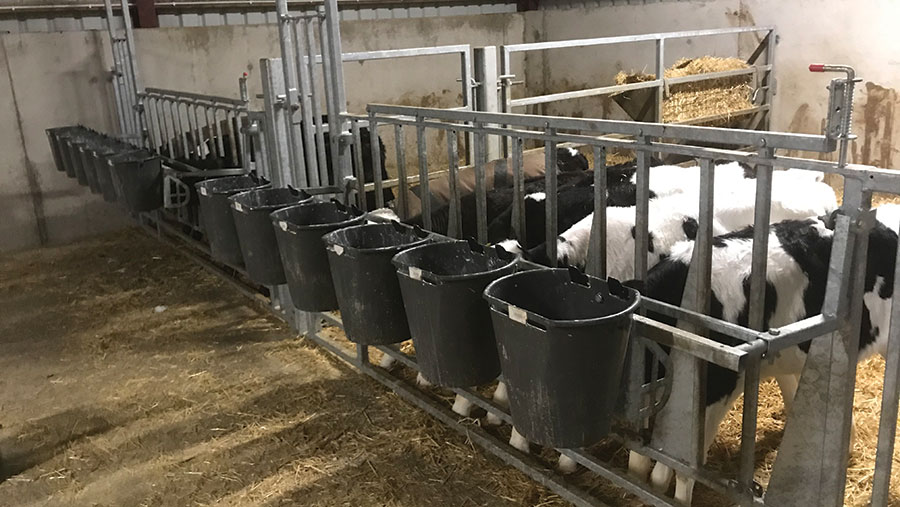
The second moving part is the headlock, which prevents fast-drinking calves from bothering slowcoaches.
It means Mr Boyd can get on with other jobs while the calves are feeding, safe in the knowledge that each one has sunk its allotted amount.
He can also quickly identify sick animals if they have gone off their milk.
Nick Eccles’ calf hutch ventilation system
Pneumonia was proving a problem for Nick Eccles’ hutch-housed calves, so he decided to assemble a circulation system that would maintain a fresh breeze through the accommodation, no matter the weather.

This, he hoped, would reduce issues on windless days when the hutches have a habit of getting stuffy, exacerbating infections.
The starting point was a solar fan, typically used to ventilate caravans, that was sourced from China for a meagre £25.
It was neatly grafted into the roof of the hutch, drawing stagnant air out and encouraging a fresh flow through the entrance. It also has a battery to keep it spinning on still days.
Andy Dymond’s ‘Xtra Arm’ cubicle brush
We have seen several cubicle brush attachments over the years of our Inventions Competition, but few look as polished as Andy Dymond’s so-called Xtra Arm.
The first iteration was assembled from scrap found on his farm at Colyton, Devon. However, after fine-tuning the design, he is hoping it will appeal to other dairy farmers looking at ways to improve bed cleanliness and reduce instances of mastitis.
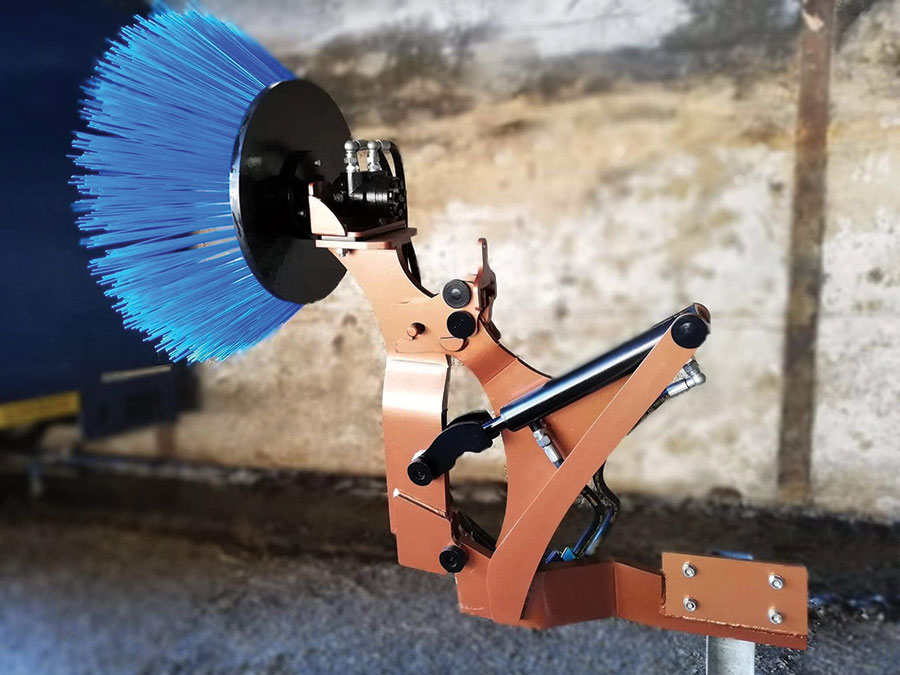
It’s attached to the front of a tractor – a two-wheel-drive New Holland, in Mr Dymond’s case – via a mounting plate that can be adapted to suit different models.
A locking pin at the top of the main frame holds the brush in its upright position when out of work. The pin can also have a rope attachment, allowing it to be pulled free without leaving the tractor seat.
Power is provided by a single spool, and brush speed is altered by adjusting a flow restrictor in the hydraulic line. A non-return valve means the brush will only spin one way, so it remains static as the hydraulic ram retracts into its upright, locked position.
Custom spacers allow the brush’s working height to be adjusted as the bristles wear and there are three grease points for maintenance.
David Devine’s mobile sheep race – intermediate category highly commended
To take a little of the hassle out of handling sheep spread over a large area, David Devine from County Londonderry, Northern Ireland, built a neat mobile race to tow behind his ATV.
His multi-use design incorporates a foot-bath and weighing crate and has the option of three-way shedding. It can also carry 10 x 1.8m and 10 x 1.2m hurdles on board.
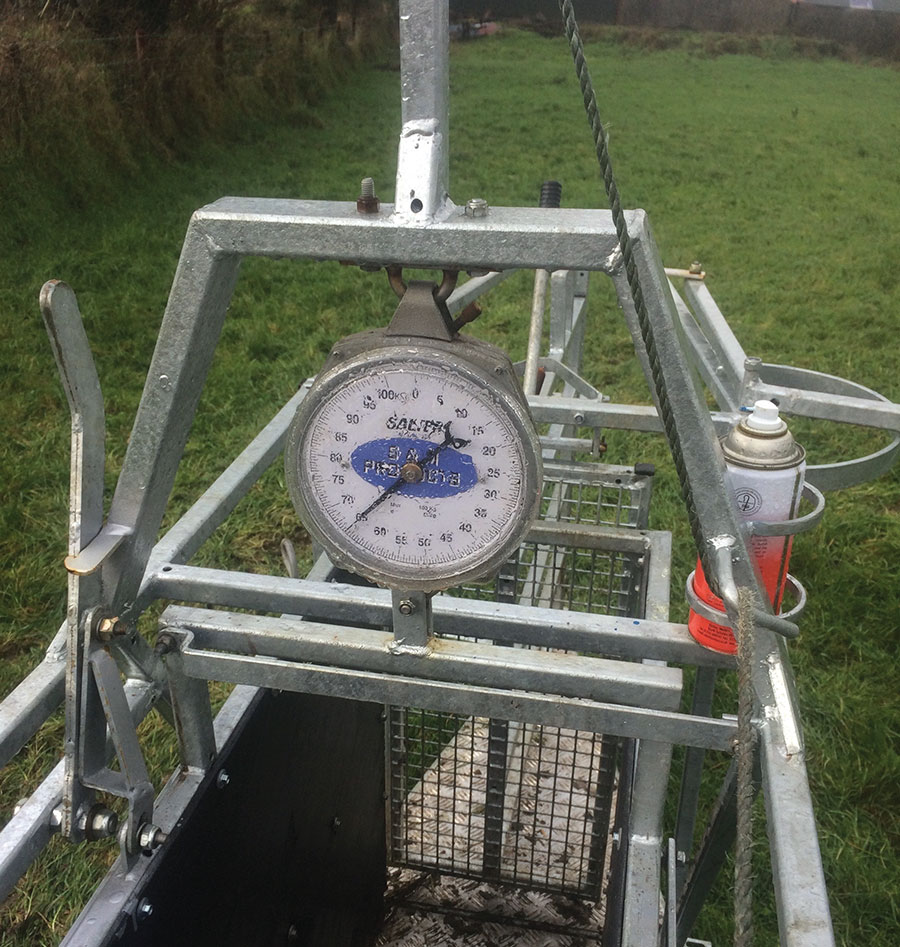
He says the setup is particularly handy in the summer, when ewes and lambs are running together in small groups. It means he can send all the animals through the foot-bath and quickly single out the heaviest lambs.
A simple strap and winder allows him to raise the rear of the crate, making it quick to remove and refit the wheels.
The entire frame was built in Mr Devine’s farm workshop and the only components he bought in were the plastic foot-bath and the Salter clock.
Once the frame was completed, he had it galvanised, before fitting a chequer plate floor and 6mm stock board on the sides.
It took a few months to put together and cost about £1,500.
Molly Robson’s sheep feeder
Eighteen-year-old Molly Robson built a feed hopper to slot in the back of a John Deere Gator, reducing the sheep feeding workload for her grandparents.
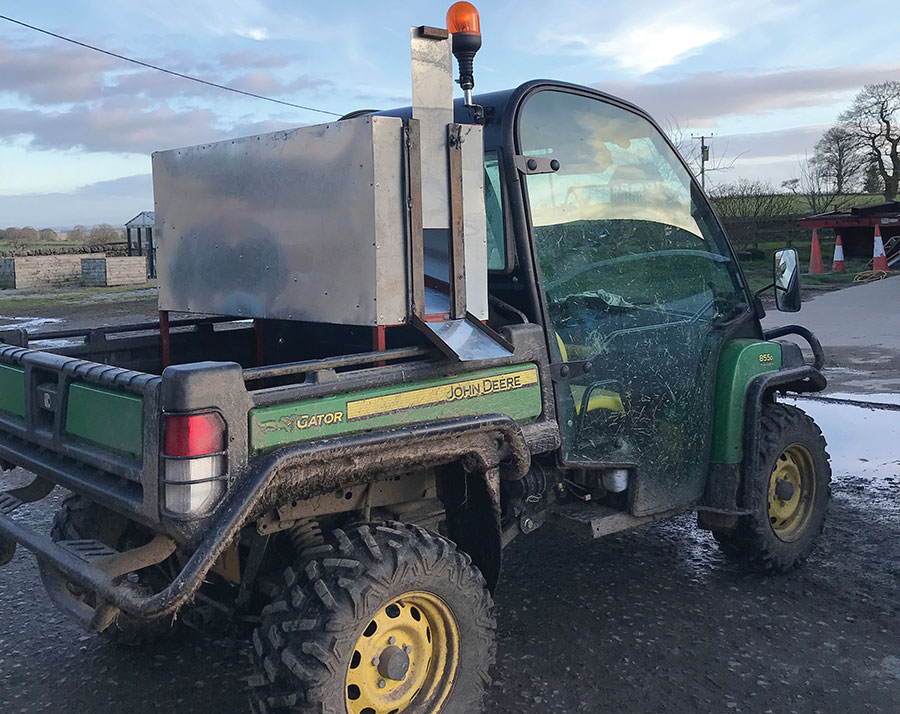
The container is strapped onto hooks on the UTV’s rear deck, so can easily be taken out and put back in using a telehandler. Feed is emptied through a sliding shutter on the side.
Nigel Rowney’s foot-trimming crush
Being 6ft 8in tall comes with its own unique set of challenges, especially when bending over to trim cow’s feet.
This issue has prompted lofty Ayrshire farmer Nigel Rowney to modify his 35-year-old Wopa cow crush to lift each one of the 600-strong herd 800mm off the floor to save breaking his back.
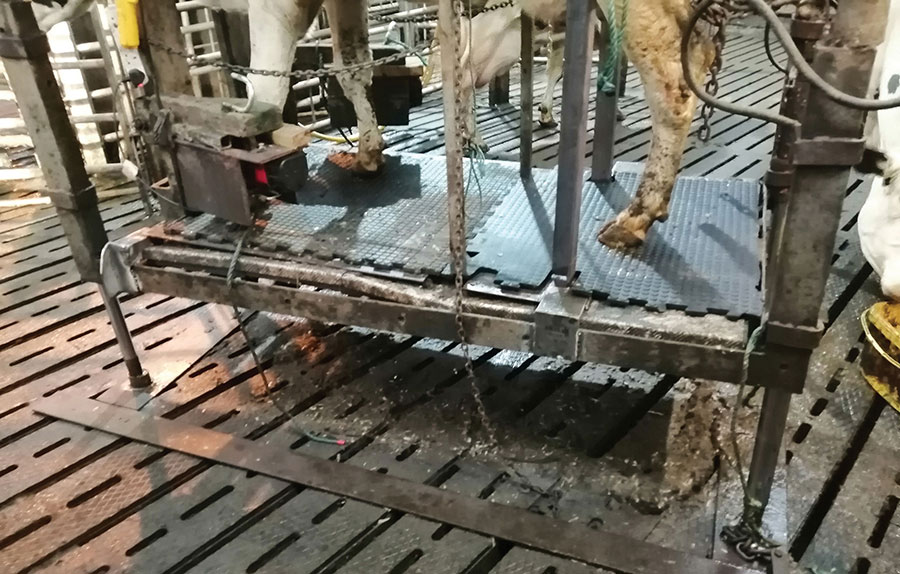
The crush is powered from the mains and runs a hydraulic power pack. There are four rams on each corner from various front-end loaders the farm has owned over the years – Massey Ferguson and David Brown units are on two of the corners.
The animal walks on and Mr Rowney raises it via a little hand control button, trims the feet and then lets it down again. He reckons his design has saved thousands on anything brand new.
Rob Frampton’s calf carrier
This year we can officially claim that the Farmers Weekly Farm Inventions Competition has gone global, with our first entry from Tasmania, Australia.
Dairy farmer Rob Frampton milks 400 cows and to put an end to having to pick up and manhandle heavy calves, he came up with a trailer that lowers to the ground using an electric winch.
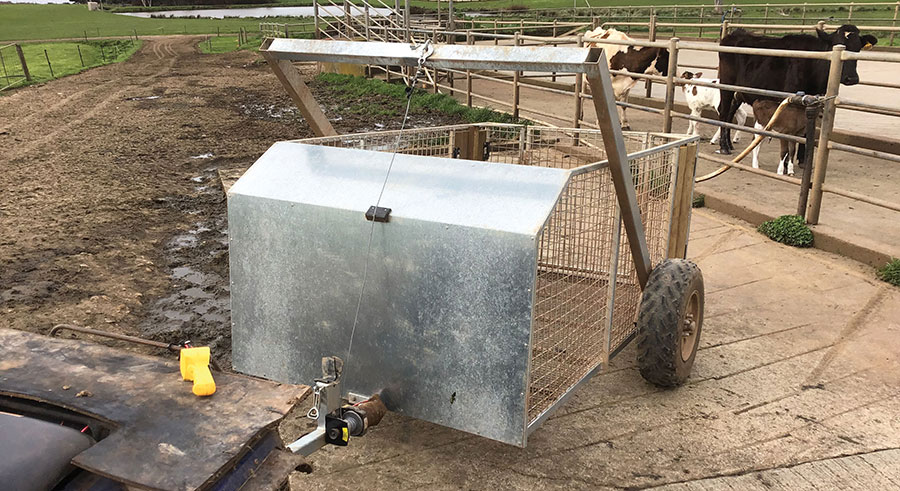
The so-called Kaleeya Calf Carrier has a clever, but simple, design where the wheels are attached to a U-shaped frame that only has two permanent attachment points at the rear of the trailer body.
During transport, the front of this is clamped to the drawbar, giving the trailer a normal ride height.
But for loading, the clamp is released and the winch is wound out, allowing the front of the U-shaped bar to rise and the rear of the trailer to drop slowly to the ground.
Mr Frampton has also fitted one-way gates so he doesn’t have to fiddle around with latches and he opted for a mesh floor, which gives plenty of grip and makes it easy to keep clean.
He says the trailer is also handy for fencing work, as makes it easy to load heavy rolls of wire. Mr Frampton put the trailer together in his shed and had it galvanised to make it last longer.
Keith Maxwell’s cattle gates
To avoid using tractors and trailers to block openings when moving cattle, Keith Maxwell built a set of cattle guide gates to help funnel the animals to their destination.
The sets weigh about 150kg and have three gates in, with a single span measuring 3.9m long by 1.4m high.
These are self-standing, thanks to some big feet at the base, but Mr Maxwell admits they work better when slightly staggered for extra stability.
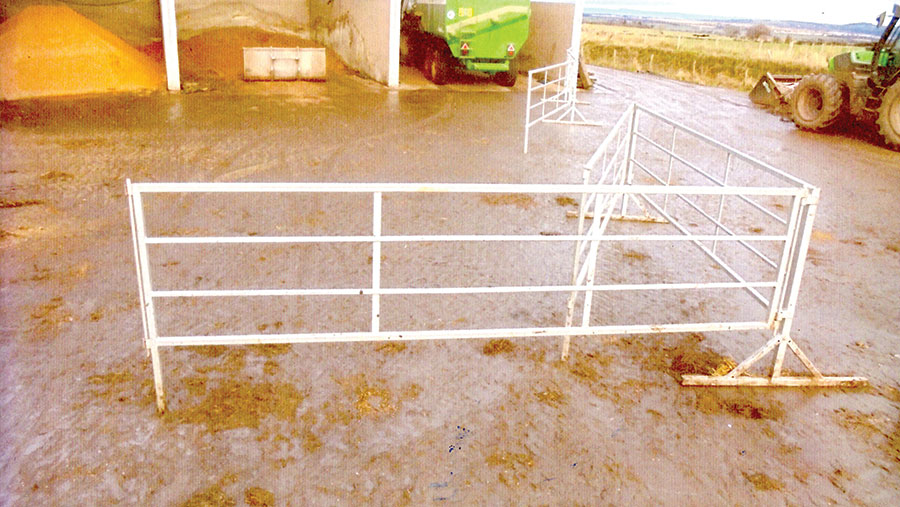
Based in East Lothian, Mr Maxwell has made six sets in total and all are galvanised before use. Helpfully, he can shift them around on the front of the telehandler and each set can be pinned to a neighbour to make some long runs.
The metal needed to build a set costs about £100 and then a further £90 for the galvanising. Mr Maxwell tends to make the gates in his spare time and reckons it takes less than four hours to manufacture a full set.
Ian Cleasby’s Scrapenser
Wanting to spend less time bedding cow pens without spending vast sums on an extra tractor, Cumbrian farmer Ian Cleasby has mounted a sand spreading box on top of his cubicle scraper to combine the two jobs.
The Scrapenser holds enough sand to bed more than 100 cubicles and is the right width to be loaded by a skid-steer loader bucket.
Under the sand is a hydraulically driven toothed belt to propel the sand into the cubicles, and the belt’s speed can be adjusted via a control panel.
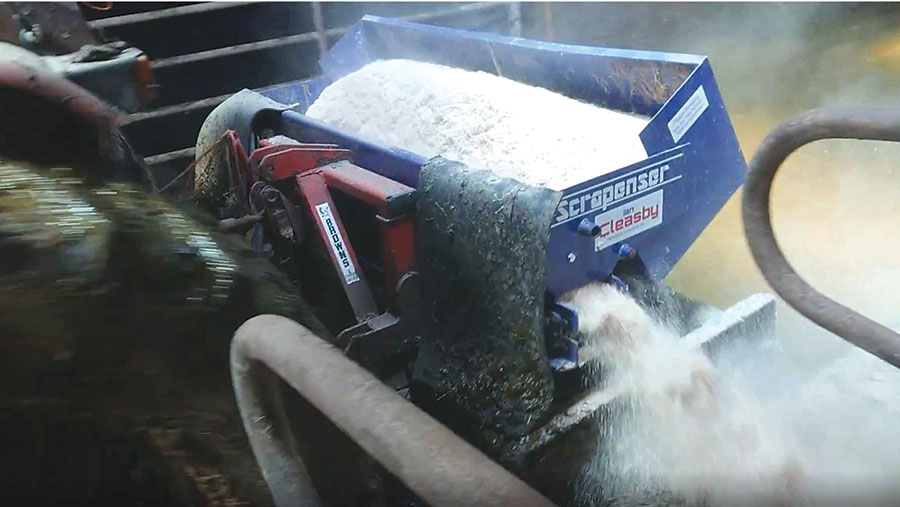
A clever hinged design brings the contents at the back of the box onto the belt at the front to make sure all the sand is spread.
Cows can then return to their cubicles quicker and it can be run on any tractor with a two-way spool valve with the belt able to discharge from both sides.
Mr Cleasby is starting to sell these commercially after the first idea way back in 2003. The retail price is £3,900.
Richard and David Pike’s sand leveller
Raking sand in cow cubicles was a two-hour job each day for Richard and David Pike while looking after their 350-strong herd in Gillingham, Dorset.
Then they had the idea popped to convert the old Terex dumper that was sat in the yard without a job into a cubicle leveller. They removed the body and attached a full-width cubicle rake to the front.
It works from the same hydraulic feeds as before, with the arm cobbled together from an old McConnel hedgecutter.
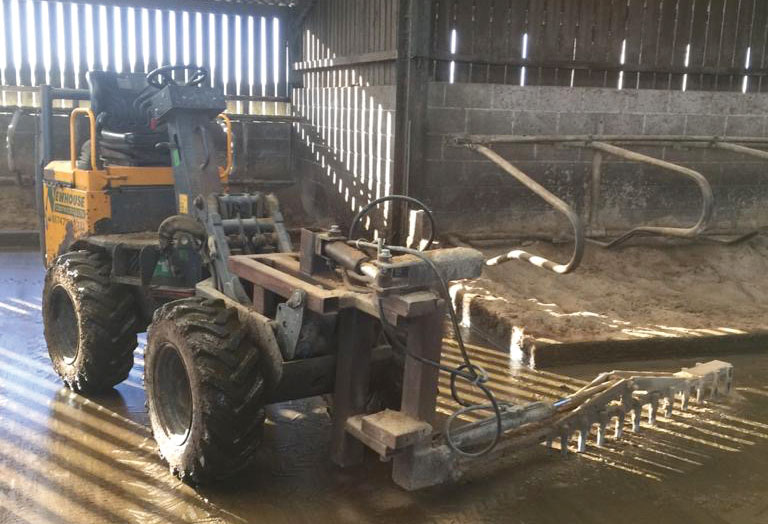
Once the farmers had realised it was a bit of a game changer, they treated the setup to some new bushes and beefed up the design a little. It took a few days to build and saves hours of raking a day and .
James Small’ cattle squeeze – simple category highly commended
James Small was having issues with cattle turning around when waiting to go into the crush. After realising there was nothing on the market to suit his need for a self-adjusting cattle squeeze, he set about designing and building his own.
The self-adjusting side squeeze can accommodate any size of animal consecutively without the need for manual adjustment.
The sides are set narrow and as an animal walks in, the boarded sides move and apply only light pressure on the animal.
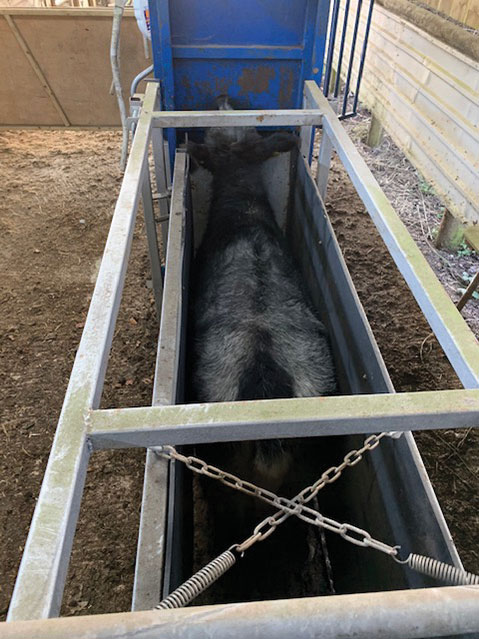
Once the cow walks through, the squeeze returns to its original size, ready for the next animal. The springs that apply the pressure are from Mr Small’s defunct children’s trampoline, and the whole build cost about £300, labour included.
He says it works with four-month-old calves, right up to the biggest bulls on the farm, set within the Mendip Hills, Somerset. Since it was built, he hasn’t had any of the 250-strong herd attempt to turn around and Mr Small says it helps to keep them calmer before going in the crush.
Oliver Uffold’s beet chopper
In a bid to speed up the chopping of beet going into cattle and sheep feed, Oliver Uffold, who farms near Craven Arms, Shropshire, created an electric pulping machine.
The starting point for the build was an old GHL chaff cutter, which he cut up and spilt the chopping rotor in half. He then remounted the two halves with the blades meshing and rigged up the driveline so they rotate toward one another.

This means the beet can be tipped into the top of the machine with a wheelbarrow, before being finely chopped and falling through a hole he cut in the bottom.
Power is provided by an electric motor that sits in place of the old petrol engine, and drive is sent to the first rotor via a belt.
Drive to the second rotor comes from a sprocket at the opposing end of the first rotor and the chain passes over an idler gear to reverse the drive to the second one.
Finishing touches included fitting a remote greasing bank for the bearings and installing weld mesh guards to protect all moving parts.
An integrated ramp was also fashioned out of an old set of twisted John Deere combine steps, making it easier to bowl the wheelbarrow up to the hopper.
According to Mr Uffold, the machine is significantly faster than the Bamfords Root Pulper they used to use and the finer chop makes it easier to mix in with concentrate cattle and sheep feed.
Marcus Tucker’s sheep foot-bath
Regular inventor Marcus Tucker came up with a portable sheep foot-bath to speed up the treatment due to their spread-out locations around the village of Talaton, Devon.
He is a strong believer that sheep should have regular foot-baths, so he made a 2.4m race to accommodate the bath he already owned.
A no-spill wooden cover was added so it can be transported without spillages and, when the sheep don’t need foot treatment, the cover can be walked on. It raises the animals up by 250mm to an ideal height for drenching.
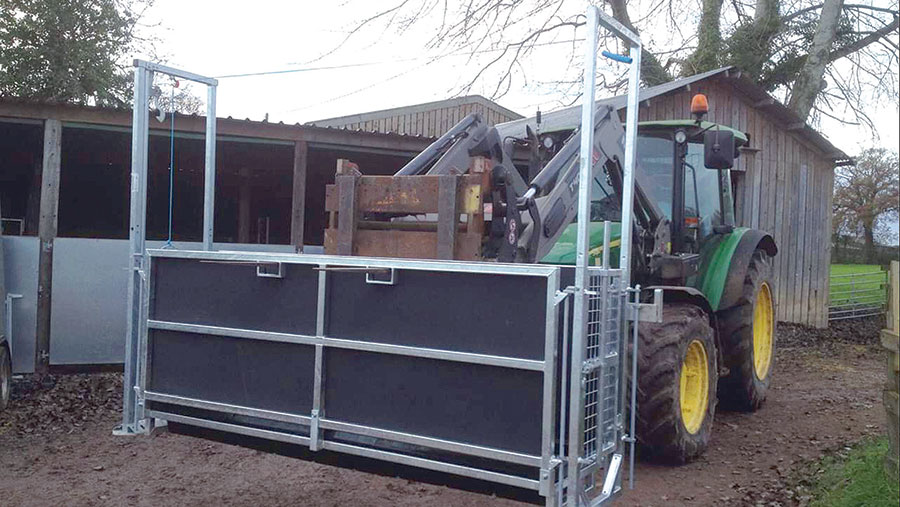
There is a small race section that has a guillotine gate on the exit and a swing gate on the entrance. Handily, the whole unit can be picked up by pallet forks and taken to wherever it is needed and there is space for a couple of 25-litre drums inside.
It took a couple of days to knock up and cost about £600, including labour. The whole frame was made out of hollow steel box section and has been galvanised to protect it.
Philip Davies’ automatic flood wash system
Dairy farmer Philip Davies has developed his own automatic flood wash system to keep shed passages, the parlour and outside collecting yards clean for his 220-cow herd.
He first developed the system for his milking parlour 19 years ago, but the latest iteration has added automated functions to eliminate operator input.
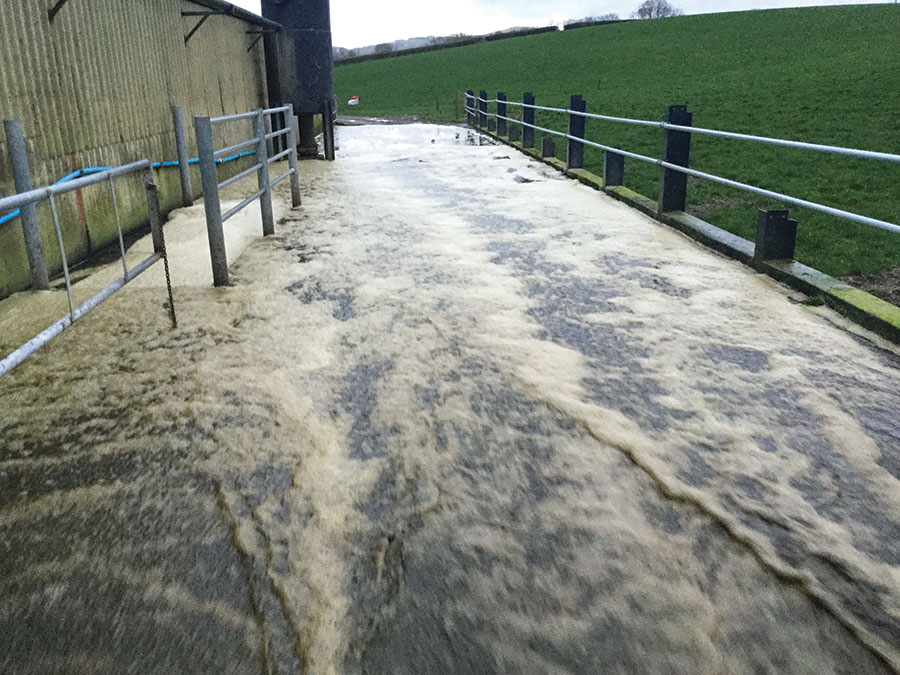
The setup centres on an 18,000-litre tank, which he mounted on 3m-high stilts in the shed. A 12cm Mono water pump brims it with recycled water until it is tripped by a level sensor.
In work, a double-acting pneumatic cylinder – powered by the parlour’s compressed air system and engaged by a 24V DC solenoid valve – opens butterfly valves on a pair of 35cm pipes.
The plumbing system is gravity fed, so when the valves are opened, a tsunami runs through the two 60m-long walkways. The same system also produces a strong enough flow to clear the 12m-wide collecting yard.
Complete automation comes by way of a timer-based control. It has two settings – the first determines the times between washes and the second dictates how long the valves are open for (typically 30secs).
Mr Davies says the system produces a far cleaner finish than a scraper tractor and it’s a massive time saver, too.
In all, it cost roughly £6,000 to assemble – one-third of which went on the pump.

